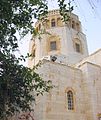
The Church of the Holy Sepulchre, also known as the Church of the Resurrection, is a fourth-century church in the Christian Quarter of the Old City of Jerusalem. It is considered to be the holiest site for Christians in the world and has been the most important pilgrimage site for Christians since the fourth century.

The Mount of Olives or Mount Olivet is a mountain ridge in East Jerusalem, east of and adjacent to Jerusalem's Old City. It is named for the olive groves that once covered its slopes. The southern part of the mount was the Silwan necropolis, attributed to the elite of the ancient Kingdom of Judah. The western slopes of the mount, those facing Jerusalem, have been used as a Jewish cemetery for over 3,000 years and holds approximately 150,000 graves, making it central in the tradition of Jewish cemeteries. Atop the hill lies the Palestinian neighbourhood of At-Tur, a former village that is now part of East Jerusalem.

Mount Scopus is a mountain in northeast Jerusalem.

Mount Zion is a hill in Jerusalem, located just outside the walls of the Old City. The term Mount Zion has been used in the Hebrew Bible first for the City of David and later for the Temple Mount, but its meaning has shifted and it is now used as the name of ancient Jerusalem's Western Hill. In a wider sense, the term Zion is also used for the entire Land of Israel.

French Hill, also Giv'at Shapira, is an Israeli settlement in northern East Jerusalem. It is located on territory that has been occupied since the Six-Day War in 1967 and later unilaterally annexed by Israel under the Jerusalem Law, in a move internationally condemned as illegal, "null and void" under international law, in 1980. The international community considers Israeli settlements in East Jerusalem, such as French Hill, illegal under international law, which the Israeli government disputes.
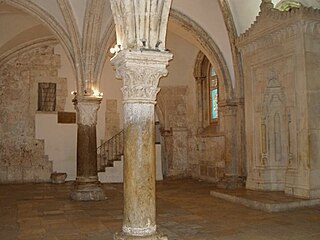
The Cenacle, also known as the Upper Room, is a room in Mount Zion in Jerusalem, just outside the Old City walls, traditionally held to be the site of the Last Supper, the final meal that, in the Gospel accounts, Jesus held with the apostles.

The city of Jerusalem is sacred to many religious traditions, including the Abrahamic religions of Judaism, Christianity and Islam which consider it a holy city. Some of the most sacred places for each of these religions are found in Jerusalem, most prominently, the Temple Mount/Haram Al-Sharif.

Tourism in Israel is one of the country's major sources of income, with a record 4.55 million tourist arrivals in 2019. Tourism contributed NIS 20 billion to the Israeli economy in 2017, making it an all-time record. Israel offers a plethora of historical and religious sites, beach resorts, natural sites, archaeological tourism, heritage tourism, adventure tourism, and ecotourism. For practical reasons, this article also covers tourism in the Israeli-occupied West Bank and the occupied Golan Heights, since it is closely interconnected with the mass tourism in Israel. Over the millennia the Holy Land has been amongst the most visited lands in the world.

Bayit VeGan is a neighborhood in southwest Jerusalem. It is located to the east of Mount Herzl, and borders the neighborhoods of Kiryat HaYovel and Givat Mordechai.

The Christian Quarter is one of the four quarters of the walled Old City of Jerusalem, the other three being the Jewish Quarter, the Muslim Quarter and the Armenian Quarter. The Christian Quarter is situated in the northwestern corner of the Old City, extending from the New Gate in the north, along the western wall of the Old City as far as the Jaffa Gate, along the Jaffa Gate - Western Wall route in the south, bordering on the Jewish and Armenian Quarters, as far as the Damascus Gate in the east, where it borders on the Muslim Quarter.

David's Tomb is a site that, according to an early-medieval (9th-century) tradition, is associated with the burial of the biblical King David. Historians, archaeologists and Jewish religious authorities do not consider the site to be the actual resting place of King David. It occupies the ground floor of a former church, whose upper floor holds the Cenacle or "Upper Room" traditionally identified as the place of Jesus' Last Supper and the original meeting place of the early Christian community of Jerusalem.

This article deals in more detail with some of the notable synagogues of Jerusalem that do not have their own page as yet.

Sheikh Jarrah is a predominantly Palestinian neighborhood in East Jerusalem, two kilometres north of the Old City, on the road to Mount Scopus. It received its name from the 13th-century tomb of Hussam al-Din al-Jarrahi, a physician of Saladin, located within its vicinity. The modern neighborhood was founded in 1865 and gradually became a residential center of Jerusalem's Muslim elite, particularly the al-Husayni family. After the 1948 Arab–Israeli War, it became under Jordanian-held East Jerusalem, bordering the no-man's land area with Israeli-held West Jerusalem until Israel occupied the neighborhood in the 1967 Six-Day War. Most of its present Palestinian population is said to come from refugees expelled from Jerusalem's Talbiya neighbourhood in 1948.
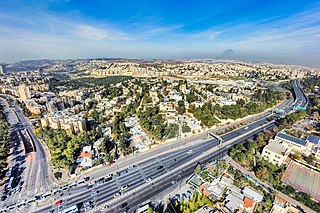
Givat HaMivtar is an Israeli settlement and a neighborhood in East Jerusalem established in 1970 between Ramat Eshkol and French Hill. It is located on a hill where an important battle took place in the Six Day War. Archaeological excavations have revealed important ancient Jewish tombs in the region. Givat Hamivtar was one of the first "Build Your Own Home" neighborhoods in Jerusalem.
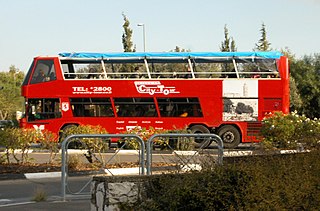
Egged Bus 99 was a bus route that was operated for tourists in Jerusalem. The bus had 29 stops It was a hop on/hop off double-decker bus that reached 35 of the leading tourist attractions in Jerusalem, provided audio commentary in eight languages.

Jerusalem Walls National Park is an Israeli national park located near the walls of the Old City of Jerusalem. The national park was designed originally to surround the old city from all sides, to separate between the old city and the new constructions surrounding it while at the same time connecting between them, while preventing construction near the walls.

Sanhedria Cemetery is a 27-dunam (6.67-acre) Jewish burial ground in the Sanhedria neighborhood of Jerusalem, adjacent to the intersection of Levi Eshkol Boulevard, Shmuel HaNavi Street, and Bar-Ilan Street. Unlike the Mount of Olives and Har HaMenuchot cemeteries that are located on the outer edges of the city, Sanhedria Cemetery is situated in the heart of western Jerusalem, in proximity to residential housing. It is operated under the jurisdiction of the Kehilat Yerushalayim chevra kadisha and accepts Jews from all religious communities. As of the 2000s, the cemetery is nearly filled to capacity.
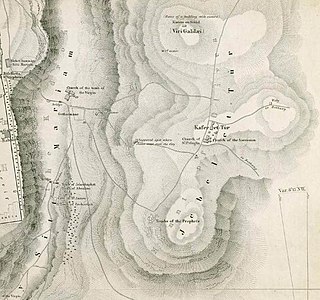
The Jewish Cemetery on the Mount of Olives is the oldest and most important Jewish cemetery in Jerusalem. The Mount of Olives has been a traditional Hebrew/Jewish burial location since antiquity, and the main present-day cemetery portion is approximately five centuries old, having been first leased from the Jerusalem Islamic Waqf in the sixteenth century. The cemetery contains anywhere between 70,000 and 150,000 tombs, including the tombs of famous figures in early modern Jewish history. It is considered to be the largest and holiest historical Jewish cemetery on earth.

Hashemite custodianship refers to the Jordanian royal family's role in tending Muslim and Christian holy sites in the city of Jerusalem. The legacy traces back to 1924 when the Supreme Muslim Council, the highest Muslim body in charge of Muslim community affairs in Mandatory Palestine, chose Hussein bin Ali as custodian of Al-Aqsa. The custodianship became a Hashemite legacy administered by consecutive Jordanian kings.


















